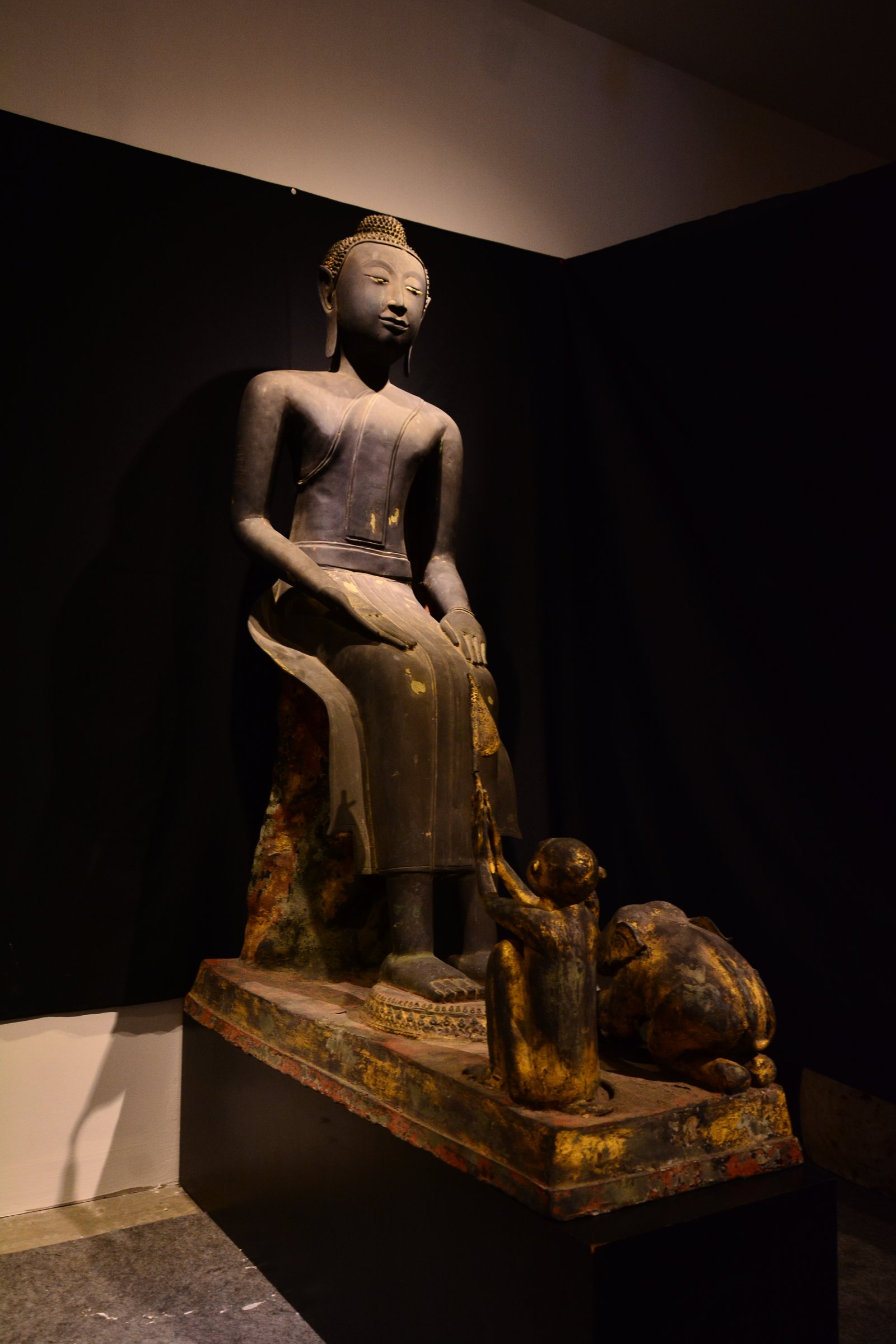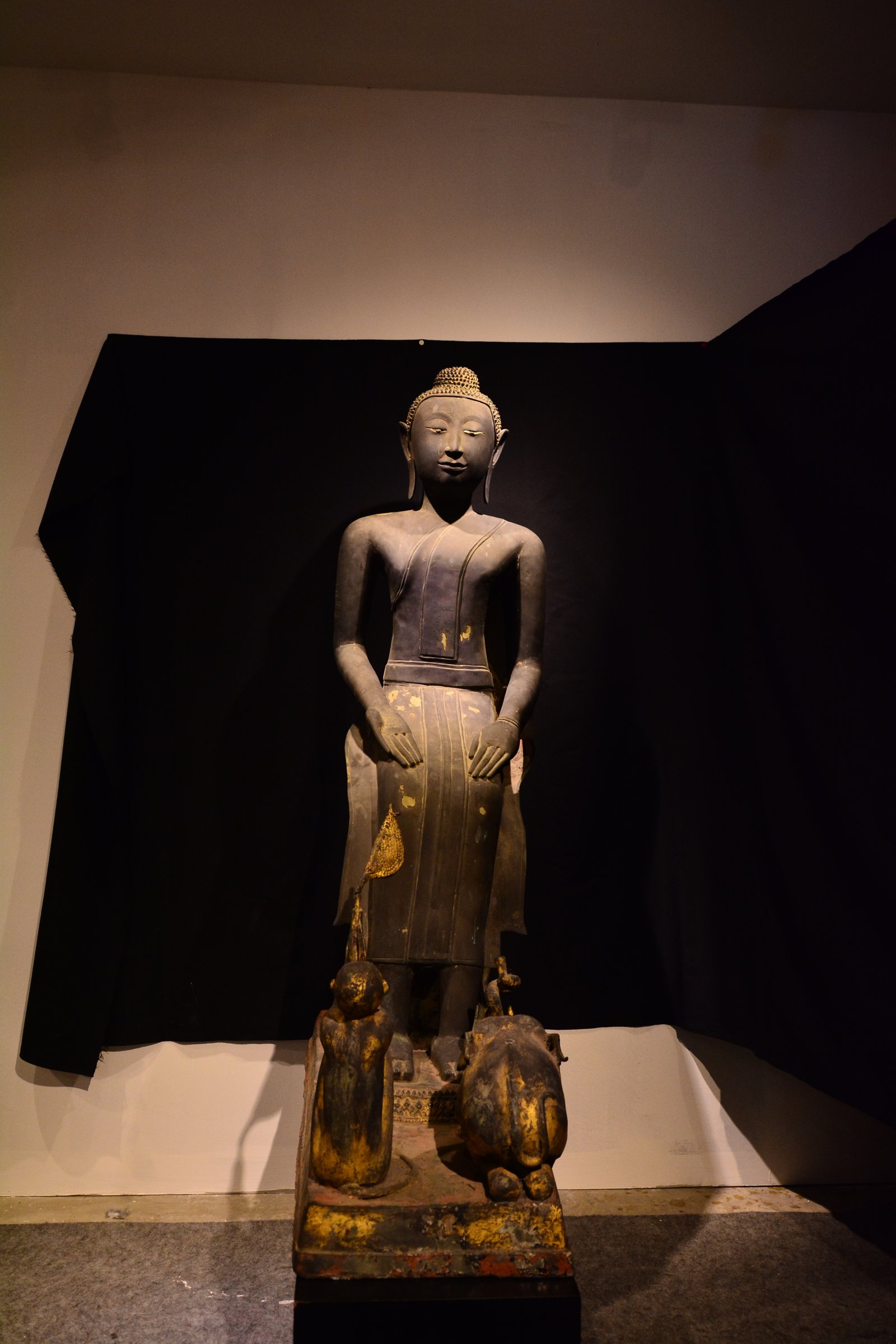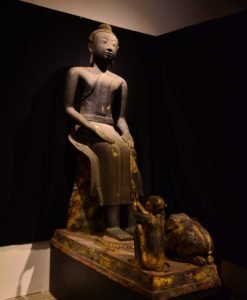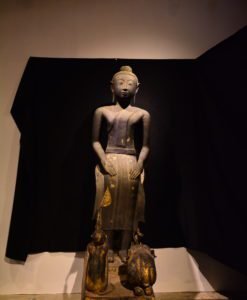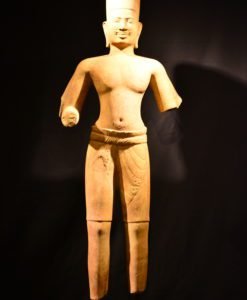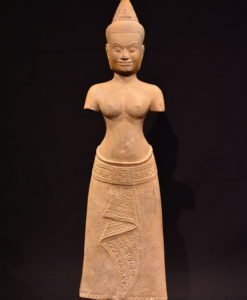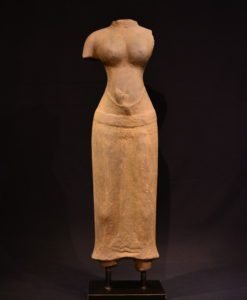Ayutthaya Period Bronze Buddha Sculpture: A Unique Depiction of the Buddha’s Compassionate Nature
A Majestic Representation of Buddha’s Compassion in Ayutthaya Bronze Sculpture
This large bronze sculpture from the Ayutthaya period (1351-1767 CE) stands as a powerful testament to the exceptional craftsmanship and profound religious symbolism of Thai Buddhist art. With its serene expression and intricate details, this piece transports the observer into the heart of Buddhist teachings.
ITEM DESCRIPTION
At nearly 2 meters tall, the Buddha is presented in a seated posture atop a simple, stone-like throne, which evokes the time when the Buddha meditated in the forests, a period marked by his personal trials and triumphs. This statue’s narrative focus stems from the Jataka tales, the sacred stories recounting the Buddha’s past lives, and here, it beautifully depicts the Buddha receiving offerings from a monkey and an elephant.
A Serene Gesture: The Right Hand in Varada Mudra
The Buddha’s right hand is positioned in a peaceful, receiving gesture, reminiscent of the varada mudra (gesture of charity), extending outward to accept offerings. This gesture underscores the Buddha’s profound compassion and his ability to receive even from humble creatures. The left hand, turned downward, is typically interpreted as a symbol of peace, further reinforcing the Buddha’s calm demeanor and harmonious nature.
This depiction of the Buddha receiving offerings from two animals—an elephant and a monkey—is symbolic of the Buddha’s compassion and kindness toward all sentient beings, regardless of their form. The monkey offers honey on a twig, and the elephant presents a branch of a tree filled with water, both offering humble gifts to the Buddha, who accepts them with grace and dignity.
The Throne: Simple Yet Symbolic
While the throne on which the Buddha sits is simple in appearance—consisting of a stone-like material—the symbolism cannot be understated. It evokes the historical narrative of the Buddha’s time spent in the jungle, where he faced trials and tested his patience and compassion. The simplicity of the throne contrasts with the elaborate ornamentation typical of many Ayutthaya sculptures, which focuses more on spiritual rather than material richness.
The bronze casting is masterful, with a subtle green patina that reflects the passage of time and enhances the statue’s authenticity. It suggests an age-old reverence for the Buddha that has survived centuries of history. Despite the presence of natural aging, the sculpture is in remarkable condition, retaining its fine detailing, especially the Buddha’s serene facial expression, a hallmark of the Ayutthaya period.
Ayutthaya Period Style: The Essence of Thai Buddhist Art
This bronze sculpture exemplifies the elegance and sophistication characteristic of Thai Buddhist art during the Ayutthaya period, where artisans excelled in creating sculptures that combined both spiritual depth and artistic refinement. Elongated limbs and a serene face are iconic features of the Ayutthaya style, as is the elegant drapery and detailed posture of the Buddha.
Jataka Tale: The Buddha’s Compassion for All Beings
The story behind the Buddha’s interaction with the monkey and elephant is derived from the Jataka tales, which depict the Buddha’s former lives in which he demonstrated compassion, moral integrity, and wisdom. The animals, in their innocent offerings, represent the respect and devotion shown to the Buddha in all forms of life. These stories play a vital role in conveying the core teachings of Buddhism, making this sculpture a poignant reminder of the Buddha’s teachings on compassion and humility.
The Buddha’s gesture of accepting offerings from animals is not merely a symbolic act, but a profound reminder of the universal compassion that transcends species, and the interconnectedness of all living beings.
Cultural Significance and Historical Context
Though the exact origin of this sculpture is unknown, it is believed to be from a temple or monastery in the Ayutthaya region, as the style is consistent with the rich cultural heritage of Thailand during the period. The Ayutthaya kingdom, known for its powerful monarchy and flourishing trade, was deeply influenced by Theravada Buddhism, which dominated the region. This period also saw significant advancements in bronze casting and sculpture, making such pieces rare and highly valuable today.
The Ayutthaya period is celebrated for its royal patronage of art, where sculptures and religious artifacts were often commissioned by the ruling class to be placed in temples and shrines as objects of veneration. This sculpture likely served a similar purpose—positioned in a sacred space to encourage reflection on the Buddha’s virtues.
A Rare Find for Collectors and Enthusiasts
This bronze Buddha sculpture is a rare and remarkable piece, representing the zenith of Ayutthaya-era craftsmanship and Buddhist iconography. Whether you are a seasoned collector, a scholar of Buddhist art, or simply someone with an appreciation for beautiful and meaningful works, this statue will add historical and spiritual depth to any collection.
The statue is not just an artistic masterpiece, but a symbol of compassion—an embodiment of the Buddha’s teachings that can inspire peace, kindness, and respect for all forms of life.
References
-
Royal Thai Government. (2020). Ayutthaya Period Art and Sculpture. Department of Fine Arts, Thailand.
-
Buddhist Art Journal. (2019). Bronze Sculptures of the Ayutthaya Kingdom. Vol. 8(3), pp. 45-68.
-
Smith, R. (2018). The Jataka Tales: Buddhist Stories of Compassion. Oxford University Press.
-
The National Museum of Thailand. (2021). Ayutthaya Art and Culture. Bangkok: National Museum.
Origin: Thailand
Period: Ayudhaya
PRODUCT DETAIL
Medium:Bronze
Dimensions:
Height – cm
Length – cm
Wide – cm
Condition Report: –
Please keep in touch for Price and more information: Mallika1013@gmail.com



